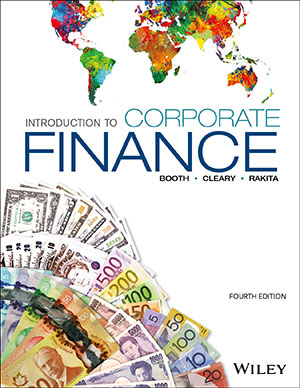
Introduction to Corporate Finance, 4th Edition
By Laurence Booth, Sean Cleary, and Ian Rakita
Introduction to Corporate Finance provides undergraduate students with the most thorough, accessible, accurate, and current coverage of the theory and application of corporate finance within a uniquely Canadian context. This program will provide students with the skills they need to succeed not only in the undergraduate course, but also in their future careers.
WileyPLUS for Introduction to Corporate Finance includes ORION Adaptive Practice that helps students build their proficiency on topics and use their study time most effectively.
Schedule a Demo Sign Up for a Test Drive Adopt WileyPLUSWant to learn more about WileyPLUS? Click Here
WileyPLUS with ORION helps you measure student outcomes.
The Performance Report helps you continuously evaluate student progress by learning objective, which is essential for continuous improvement.
Students learn to improve problem-solving skills.
solving sample problems from the textbook.
Topics are connected to actual business situations.
Corner Suite Videos feature the authors’ interviews with prominent leading professionals, providing insight into the world of finance and connecting theory to the real world.
- Student-Friendly Content: To help aid students’ comprehension and retention
- New Mini-Cases: Intended to test students’ understanding of multiple concepts in the chapter
- Authentic Videos: Providing insight into the world of finance to connect theory to the real world
Features Include:

Laurence Booth, DBA, MBA, MA (Indiana University); BS (London School of Economics), is Professor of Finance and holds the CIT chair in structured finance at the Rotman School of Management, University of Toronto. His major research interests are in corporate finance and the behaviour of regulated industries. He has published over 70 articles in numerous journals including Journal of Finance and Journal of Financial and Quantitative Analysis, has co‐authored a textbook on international business and two on corporate finance, and is on the editorial board of several academic journals.
At the University of Toronto since 1978, Professor Booth has taught graduate courses in business finance, international financial management, corporate financing, mergers and acquisitions, financial management, financial markets, applied asset management, and financial theory, as well as many short executive courses. He has been the primary doctoral supervisor for 16 students at the University of Toronto. His advice is frequently sought by the media, and he has appeared as an expert financial witness in both civil cases and before various regulatory tribunals in Canada.

Sean Cleary, CFA, is the BMO Professor of Finance at the Smith School of Business, Queen’s University. Dr. Cleary holds a PhD in finance from the University of Toronto, an MBA, is a Chartered Financial Analyst (CFA) charter holder, and is a former board member of both the Atlantic Canada and Toronto CFA societies. He has also completed the Professional Financial Planning Course (PFPC), the Canadian Securities Course (CSC), and the Investment Funds Institute of Canada (IFIC) Mutual Fund Course. Dr. Cleary has taught numerous university finance courses as well as courses and seminars in many programs designed to prepare students to write exams for all three levels of the CFA program and the CSC. He is the Canadian author of the first three editions of Investments: Analysis and Management and the co‐author of the sixth edition of Finance in a Canadian Setting, both published by John Wiley & Sons Canada, Ltd. He is also the author of the first four editions of The Canadian Securities Exam Fast Track Study Guide, also published by Wiley.
Dr. Cleary has published numerous research articles in various journals, including Journal of Finance, Journal of Financial and Quantitative Analysis, Financial Management, Journal of Banking and Finance, and Journal of Financial Research among others. He has received several major research grants from the Social Sciences and Humanities Research Council of Canada (SSHRC). He currently serves as associate editor (Finance) of Canadian Journal of Administrative Sciences and associate editor of European Journal of Finance. Dr. Cleary makes frequent appearances on television and the radio and has been featured in several newspapers.

Ian Rakita, CFA, started teaching in the Department of Finance at Concordia University’s John Molson School of Business in 1993 after extensive industry experience. He received his Bachelor of Science degree from McGill University, where he majored in mathematics, and his MBA from Concordia University. He earned his PhD from Concordia in 2000. During 1997–1998 he taught at Wilfrid Laurier University in Waterloo, Ontario, where he received a commendation for teaching excellence. Dr. Rakita teaches courses at the undergraduate and graduate level in corporate finance, fixed income securities, and derivatives. He has also taught courses in operations research and business statistics. His research interests are in the microstructure of new and secondary equity offerings as well as the efficiency of Canadian capital markets.
Dr. Rakita has published articles in Journal of Banking and Finance, Multinational Finance Journal, The Engineering Economist, Canadian Investment Review, and Journal of the Operational Research Society. He is the only two‐time winner of the Gold Prize for outstanding paper awarded in an annual contest sponsored by the Montreal Society of Financial Analysts, where he has also served on the board of directors. Dr. Rakita completed the requirements for the Chartered Financial Analyst designation in 2001. He is currently the Director of the MBA program at Concordia University’s Goodman Institute of Investment Management. This specialized MBA program links the requirements of the CFA curriculum with the academic requirements of a traditional MBA degree.
Part 1: The Financial Environment
Chapter 1: An Introduction to Finance
Chapter 2: Business (Corporate) Finance
Part 2: Financial Analysis Tools
Chapter 3: Financial Statements
Chapter 4: Financial Statement Analysis and Forecasting
Part 3: Valuation Basics
Chapter 5: Time Value of Money
Chapter 6: Bond Valuation and Interest Rates
Chapter 7: Equity Valuation
Part 4: Portfolio and Capital Market Theory
Chapter 8: Risk, Return, and Portfolio Theory
Chapter 9: The Capital Asset Pricing Model (CAPM)
Chapter 10: Market Efficiency
Part 5: Derivative Securities
Chapter 11: Forwards, Futures, and Swaps
Chapter 12: Options
Part 6: Long-Term Investment Decision
Chapter 13: Capital Budgeting, Risk Considerations, and Other Special Issues
Chapter 14: Cash Flow Estimation and Capital Budgeting Decisions
Chapter 15: Mergers and Acquisitions
Chapter 16: Leasing
Part 7: Long-Term Financing
Chapter 17: Investment Banking and Securities Law
Chapter 18: Debt Instruments
Chapter 19: Equity and Hybrid Instruments
Chapter 20: Cost of Capital
Part 8: Financial Policies
Chapter 21: Capital Structure Decisions
Chapter 22: Dividend Policy
Part 9: Working Capital Management
Chapter 23: Working Capital Management: General Issues
Chapter 24: Working Capital Management: Current Assets and Current Liabilities

